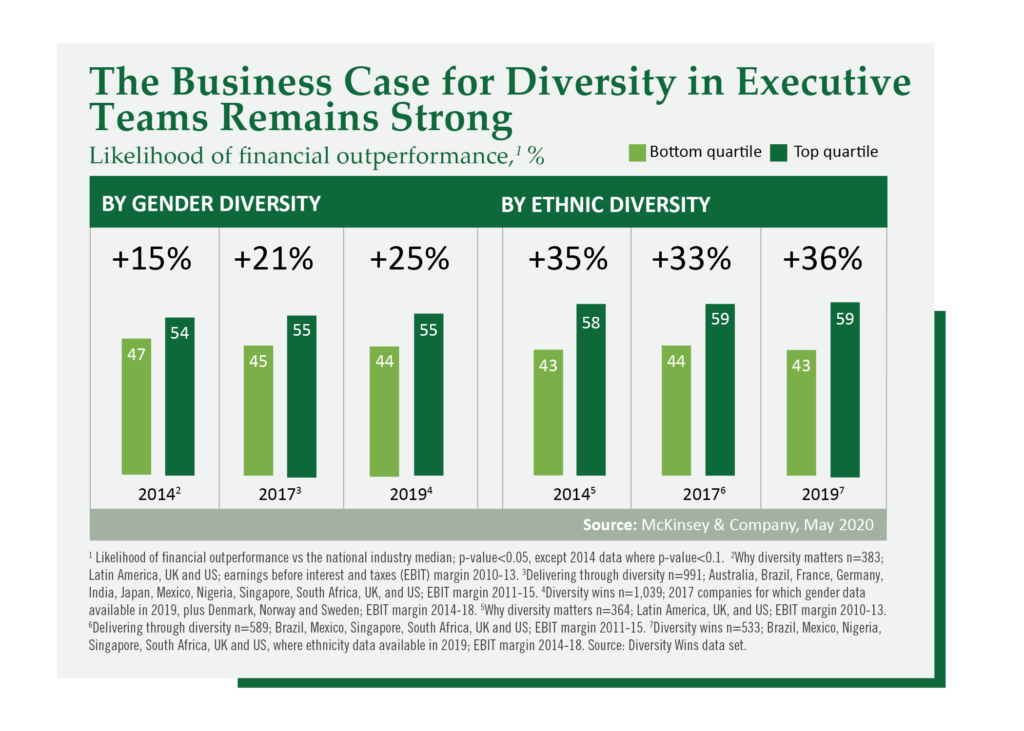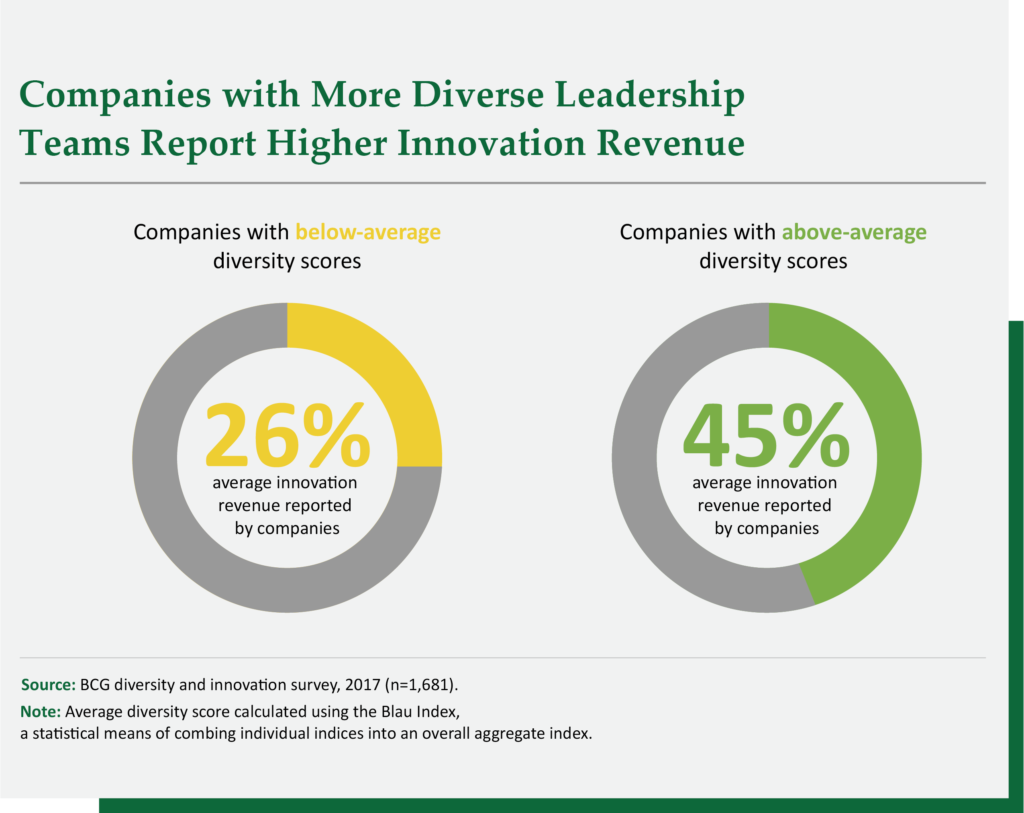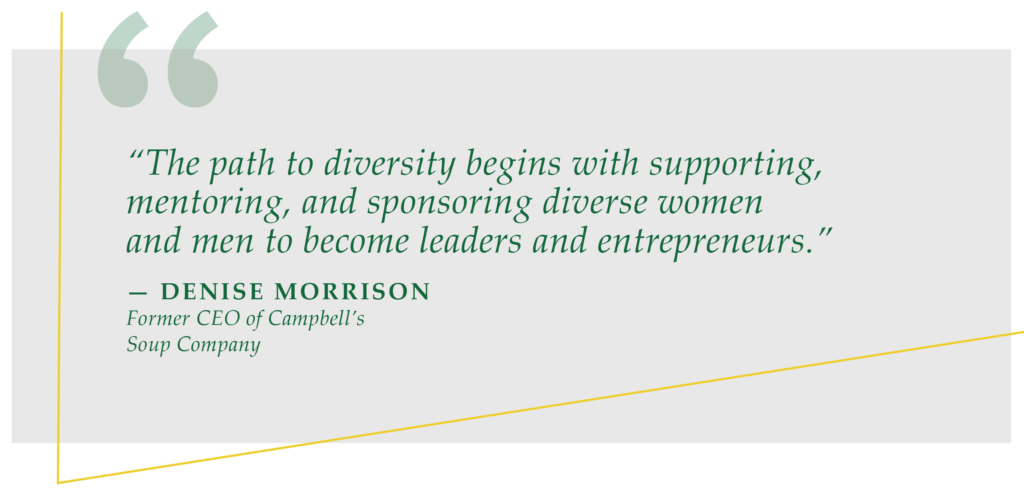Striving toward a more diverse workforce is not new. It has been incrementally happening for the last few decades; recent years and events have brought a renewed focus, sense of urgency, and understanding.
Disparities that may otherwise have been overlooked are now in the spotlight, and that includes the lack of diversity in leadership throughout the industries of food and agriculture. Consider that a small fraction of food companies made it on Diversity Inc’s Top 50 Companies for Diversity in 2021 – it is easy to understand that we need to set our sights higher.
Kincannon & Reed has seen meaningful progress working with clients over the last decade – we have experienced a 14% growth* in the placement of diverse candidates and have identified key hurdles as well as observations for the successful recruitment, hiring, and retention of diverse leaders to serve the food-value chain.

Some of the companies we serve have fully embraced making diversity part of their mission and values – and these are the organizations that attract diverse leaders who drive organizational success. Organizations that have a diversity statement but lack the behaviors to reinforce its role in their culture and decision-making, create a monumental hurdle as prospective candidates are actively seeking out this focus. These individuals tell us the lack of follow-through negatively impacts their interest in what otherwise would be a great opportunity. Even further behind are organizations that are not even thinking about diversity. If this is not prioritized until they are seeking a new leader, it is simply too late.
Throughout the food and agriculture industries organizations balance the challenge of executive positions located in geographical areas that may not be as attractive to prospective candidates, especially diverse professionals. Our clients who have successfully overcome this hurdle have been intentional about inviting diverse team members to be a part of the interview process, making sure there is an inclusion strategy in place, and evaluating remote work flexibility.
Paul Miller, K&R Managing Director, knows the value of a diverse workforce. “In my career prior to joining Kincannon & Reed, I served in leadership roles in the meat processing and baking industries and saw how varied experiences, backgrounds, cultures, races, and genders enhanced the workplace. They lead to a vibrant environment with diversity of thought and innovative approaches that not only result in rewarding work, but also, frankly, better products and services.”
Resourcing for many organizations is a hurdle that needs to be overcome. Paul has witnessed cases where the resources needed to promote diversity were lacking. Investments should be made in training staff on unconscious bias and developing inclusion strategies. “You must have a passion for this. If not, you’ll be called out as ‘faking it’ by both current employees and prospective candidates.”
First and foremost, overcoming hurdles and promoting diversity in the workplace is simply the right thing to do. Everyone should have equal opportunities to succeed. Second, companies and employees today demand it. And third, the research shows that companies with the most diverse workplaces are the most successful.
Consider “Diversity wins: How inclusion matters,” a recent McKinsey report that highlights the business case for inclusion and diversity. According to the report, companies in the top quartile of gender and ethnic diversity were more likely to exceed the performance of companies with fewer diverse leaders on their executive teams.

The most diverse companies are now more likely than ever to outperform less diverse peers on profitability. The data illustrates that the relationship between diversity on executive teams and the likelihood of financial success is not only correlated – it has strengthened over time.
Forward-thinking companies understand the importance of diversity in leadership roles today, but also see the value long-term and make diversity a priority as they look toward succession planning. As we partner with clients around the globe and across the food chain, we see firsthand the role innovation is playing in the success of food and agriculture companies. According to a 2018 study from Boston Consulting Group (BCG), there is a strong correlation between the diversity of management teams and overall innovation. The research found that companies reporting above-average diversity on their management teams also reported “innovation revenue” that was 19 percent higher than that of companies with below-average leadership diversity – 45 percent of total revenue versus just 26 percent.
In other words, according to BCG, nearly half of the revenue of companies with more diverse leadership teams comes from products and services launched in the past three years. These companies are better able to innovate and adapt to changes in customer demand.

So, what does it take to foster a diverse workforce across the food and agriculture value chain?
A candidate can check every box for skills and align with their values around sustainability and suit their budget and taste preferences. An ever- changing consumer requires outside-the-box thinking. How do you ensure your company is able to break the mold and think about consumers of expertise, but if you want a long-term match, cultural fit is an element of equal importance. In Miller’s searches, he encourages hiring managers and a broader team to share what it is like to work at their company. This enables him to understand the operational inner workings, how decisions are made, the process of onboarding, and the company’s history of inclusion. In other words, he breaks down culture into tangible pieces that can be discussed with candidates throughout the search process. This attention to detail not only ensures that the new hire will be comfortable and excel, but, more importantly, that they will feel included and engaged for years to come.
In 2020, many of the executive leaders Miller placed had offers at other companies for more money, but they had truly connected with their prospective new team and colleagues – and that cultural fit was exactly the incentive they were seeking. Their goal was to not only receive an offer, but to be a part of the long-term success of the organization, playing a meaningful role. We consistently find that executives are looking for that “great fit” in their next career move, and diverse candidates are likely to prioritize culture in their job searches.
Today’s consumer is more discerning – and skeptical – than ever before. They drive demand for foods that meet their nutritional needs, match their ideologies regarding production systems, tomorrow (while also meeting the ever-changing needs of today’s consumers)? We help companies consider candidates who don’t look like the ‘usual suspects’ with sector-specific expertise.
Of course, there are some nuances in food and agriculture where specific experience in sectors or expertise on critical topics is necessary. But for some roles, bringing the outside in provides a new set of considerations, perspective, and clarity.
Cross-sector recruitment is an area of passion and expertise for Kincannon & Reed principals. Our search efforts are as broad as necessary to ensure we place candidates who have skills and background uniquely suited for the position. Our path to success lies in our deep networks, extensive research, organizational mapping, and a proprietary database that includes top performers from target and adjacent sectors.
Recently, a search conducted for a vice president role at a large beverage company ended with a perfect candidate who came from a paint company and did not look like many of the leaders who previously held the position. Our client was skeptical when the candidate was initially presented, but soon realized the skillset required was more prevalent in executives outside of its industry and our candidate was clearly the best choice.
Consider that the BCG study uncovered that if just two percent of a company’s leadership team came from a different industry, the “innovation revenue” would increase a full percentage point. Small changes can have a big impact – and that is why we encourage our clients to think differently about candidates to consider.
Companies committed to diversity must have leaders who are committed to the effort. It is up to the president, CEO, or board to say, “this is what we need to do” and make diversity part of the company’s values and mission – and ensure it is not deprioritized over time.
Depending on the company, there may be an opportunity to create a position dedicated to diversity, equity, and inclusion (DEI) or to hire a consultant to review and provide guidance to ensure the tenets of a DEI program are established, instituted, and followed through at every level. The McKinsey research indicates that the companies doing this best are adopting systematic, business-led approaches to inclusion and diversity.
When you hire, look ahead. Consider the talents and contributions of the current employee – and identify what success looks like five years from now. That helps lay the groundwork for how you can help them continue current success while preparing them for the intended future. Key to this approach is securing mentors who will help them embrace current abilities, while encouraging, stretching and molding them to new success along their journey with the organization.
Paul shares that mentoring others throughout his career has brought great joy and is one of the most rewarding ways to give back and support the industry’s future success. In particular, he has prioritized mentoring several women and ethnically diverse individuals into executive leadership roles – all of whom have recognized how his guidance, support, and council have helped throughout their careers. Paul said, “I love it when people are given opportunities and that’s part of what we do every day. Mentoring helps people reach their aspirations and potential, while helping companies retain a great leader.”

Some say leadership teams should mirror the diversity of a local or regional population. While this may be ideal, it may not always be realistic, but it is a good metric from which to start.
The reality is that companies lacking a focus on fostering diverse workplaces will be left behind. Those who make it a priority will enhance company culture, promote innovative thinking, and drive success.
Paul’s reflection of his forty-year career summarizes just how far we have come. It also shines a light on the value of continually working towards having the best leaders in our organizations and knowing what the definition of “best” is for each company.
“At Kincannon & Reed we’ve seen a lot of change across the food and agriculture industries over the past 40 years.” Paul adds, “The most exciting time is yet to come as consumers continue to care more about where their food comes from. There is innovation that can feed the growing population and the strong leadership across the food, agriculture, and other industries will bring this all together. This momentum can be greatly enhanced as companies promote diversity on their executive teams. And I’m proud to work for a company that’s helping the industry do just that.”
If you are interested in learning more about Kincannon & Reed, let’s connect.